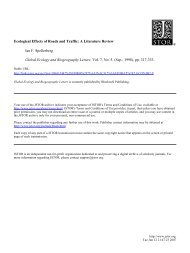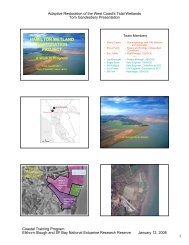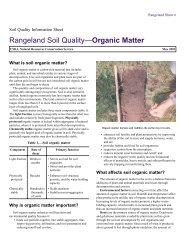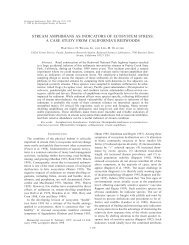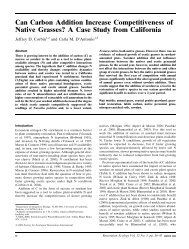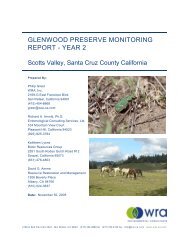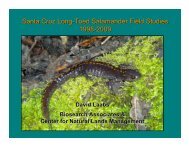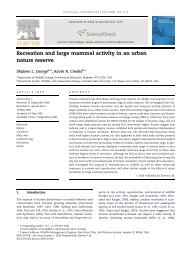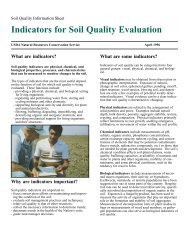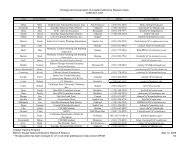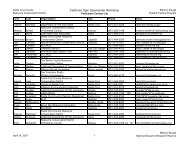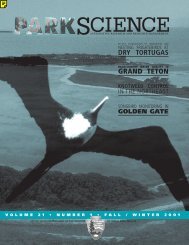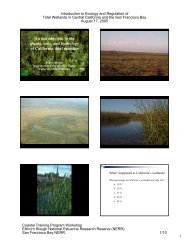Bird Populations 10:90-109© The Institute for Bird Populations 2010THE 2003-2008 SUMMARY OF THE NORTH AMERICANBREEDING <strong>BIRD</strong> SURVEY 1DAVID J. ZIOLKOWSKI JR 2 ., KEITH L. PARDIECK AND JOHN R. SAUERUSGS Patuxent Wildlife Research Center12100 Beech Forest RoadLaurel, MD 20708-4038Abstract. Data from the North American Breeding Bird Survey were used to estimatecontinental and regional changes in bird populations for the 6-yr period 2003-2008 andthe 2-yr period 2007-2008. These short-term changes were placed in the context ofpopulation trends estimated over the 1966-2008 interval. Across the entire survey area, ahigher proportion of species exhibited positive growth during 2003-2008 (64%) thanduring the long-term (46%) or the more recent 2-yr-term (39%). The 2003-2008 growthoccurred relatively evenly across the Western, Central, and Eastern BBS regions, with59%, 66%, and 61% of all species increasing, respectively. We additionally evaluated theproportion of species with positive trend estimates in each of 12 life-history basedgroupings at continental and regional levels. Survey-wide, birds in the grassland guilddemonstrated the lowest proportion of positive trends over the entire survey period(21% increasing), with significant declines occurring in both the Eastern and Westernregions (5% increasing and 18% increasing, respectively). Birds in the wetland breedingguild exhibited the greatest proportion of positive trends, with a significant number ofincreasing species (between 77-90%) occurring in all three BBS regions during 2003-2008.Key Words: North American Breeding Bird Survey, population trends, roadsidesurveys, species group analysis.RESUMEN DEL CONTEO DE AVES REPRODUCTORAS (BBS) DENORTEAMÉRICA DESDE 2003 Y 2008Resumen. Datos del Conteo de Aves Reproductoras (BBS) de Norteamérica fueronutilizado para estimar los cambios continental y regional en las poblaciones de aves en elperiodo de 6 años 2003-2008 y el periodo de dos años 2007-2008. Estos cambios a cortoplazo fueron situados en el contexto de las tendencias poblacionales estimadas en elintervalo 1966-2008. En la escala continental, una mayor proporción de las especiesmostraron un crecimiento positivo durante 2003-2008 (64%) que en el periodo de largo plazo(46%) o en el período más reciente de 2 años (39%). El crecimiento de 2003-2008 se ocurrióde manera relativamente uniforme a través de las regiones Oeste, Central y Este del BBS,con el 59%, 66% y el 61% de las especies aumentando, respectivamente. Además, evaluamosla proporción de especies con tendencias positivas en las escalas continental y regional para12 grupos de especies que comparten características de historia de vida. En la escalacontinental, las aves de pradera mostraron el porcentaje más bajo de especies con tendenciaspositivas (21% aumentando) con declives significativos detectado en las regiones Este yOeste del BBS (5% aumentando y 18% aumentando, respectivamente). Aves que sereproducen en humedales mostraron la mayor porcentaje de las tendencias positivas, con unnúmero sigivicativo de especies con tendencias positivas (77-90%) detectado en las tresregiones del BBS durante 2003-2008.Palabras clave: Conteo de Aves Reproductoras de Norteamérica, tendencias poblacionales,conteos en carreteras, análisis por grupos de especies.____________________1 Received: 8 October 2010. Accepted 13 October 2010.2 Corresponding author, dziolkowski@usgs.gov[90]
NORTH AMERICAN BREEDING <strong>BIRD</strong> SURVEY 2003-2008INTRODUCTIONInitiated in 1966, the North American BreedingBird Survey (BBS) is the primary source ofstandardized population data for breeding birdsin the U.S. and Canada. For most avian breedingspecies in North America, it is the only availablesource for long-term population trend estimatesand relative abundance measures at largegeographic scales. The BBS was initiated by theU.S. Fish and Wildlife Service and CanadianWildlife Service and is currently administered bythe U.S. Geological Survey (USGS) and CanadianWildlife Service (CWS). In 2007, Mexico’sNational Commission for the Knowledge andUse of Biodiversity (CONABIO) partnered withthe USGS and CWS to expand the BBS intoMexico. A sampling framework, includinghundreds of new routes, is currently indevelopment across the northern tier of Mexicanstates, putting the survey closer to its goal ofmaking the BBS a fully North Americanprogram.This summary presents continent-wideestimates of population trends for 422 birdspecies and four species groups [Western/Clark’s Grebe (Aechmophorus clarkii/A.occidentalis), Willow/Alder Flycatcher(Empidonax traillii/E. alnorum), Pacific-slope/Cordilleran Flycatcher (Empidonax difficilis/E.occidentalis), and Yellow-bellied/Red-naped/Red-breasted Sapsucker (Sphyrapicus varius/S.nuchalis/S. ruber)] for the period 1966-2008.Although these four groupings currently consistof taxonomically distinct species (AOU 1998),each was viewed as a single taxon when the BBSwas initiated and early data collected from areasof sympatry cannot be discriminated adequatelyto permit contemporary range-wide species-levelanalyses. In this report we discuss the 6-yrtrends, 2003-2008, and 2-yr trends, 2007-2008,within the context of long-term changesestimated over the 1966-2008 interval. Detailedanalyses and discussion of population changesfor individual species within specific regions,states, provinces, territories, and physiographicstrata are beyond the scope of this summary.Also included in this summary are thecontinental and regional trends for 12 groups ofbirds sharing similar life-history traits. Analysesof group trends can provide insight into thebroad temporal and geographic patterns ofpopulation trends, especially when viewed in thecontext of previous BBS summaries (Pardieckand Sauer 2007, 2000; Peterjohn and Sauer 1993;Peterjohn et al. 1994, 1996).METHODSThe BBS consists of over 4600 active surveyroutes randomly located across the continentalUnited States, Canada, and northern Mexico [Seethe North American Breeding Bird Survey website (www.pwrc.usgs.gov/bbs/) for mapsdepicting the approximate locations of theseroutes]. Since 1994, the number of routessurveyed in the United States and Canada hasremained relatively constant at about 3000 routes.A total of 2980 routes were sampled in 2003, 2995in 2004, 3059 in 2005, 3058 in 2006, 3111 in 2007,and 3022 in 2008.The BBS methodology is described brieflyhere; see Robbins et al. (1986) for a detaileddescription. The BBS is a roadside surveyprogram consisting of 39.4-km (24.5-mi) routes,with stops placed at 0.8-km (0.5-mi) intervals fora total of 50 stops. Routes are randomlyestablished on suitable roads and surveyed onceper year during the height of the breeding season(June for most of the U.S. and Canada). At eachstop, a skilled amateur or professionalornithologist records all birds seen within a 0.4-km (0.25-mi) radius and every bird heard, duringa 3-min point count. For each species, the sum ofthe counts from the 50 points is used as an indexto abundance along the route for that year.ESTIMATION OF POPULATION TRENDPopulation change was estimated using ahierarchical log-linear model fit to BBS data withMarkov chain Monte Carlo (MCMC) methods.Hierarchical models provide a natural frameworkfor accommodating differences in qualityof information among regions and the MCMCprocedure provides a convenient tool forestimating composite results. The hierarchicalmodel analysis was first described by Link andSauer (2002) and we note that this report is theinaugural summary report using this analysis.Sauer and Link (2010) conducted a comprehensivecomparative analysis of BBS data usinghierarchical model and route regression results,and we refer readers to that evaluation for detailsof both the analytical method, its implementationfor BBS data, and the similarity of results[91]
- Page 1 and 2:
BIRD POPULATIONSA journal of global
- Page 3 and 4:
BIRD POPULATIONSA journal of global
- Page 6 and 7:
ROBERT L. WILKERSON AND RODNEY B. S
- Page 8 and 9:
ROBERT L. WILKERSON AND RODNEY B. S
- Page 10 and 11:
ROBERT L. WILKERSON AND RODNEY B. S
- Page 12 and 13:
ROBERT L. WILKERSON AND RODNEY B. S
- Page 14 and 15:
ROBERT L. WILKERSON AND RODNEY B. S
- Page 16 and 17:
ROBERT L. WILKERSON AND RODNEY B. S
- Page 18 and 19:
ROBERT L. WILKERSON AND RODNEY B. S
- Page 20 and 21:
ROBERT L. WILKERSON AND RODNEY B. S
- Page 22 and 23:
ROBERT L. WILKERSON AND RODNEY B. S
- Page 24 and 25:
ROBERT L. WILKERSON AND RODNEY B. S
- Page 26 and 27:
ROBERT L. WILKERSON AND RODNEY B. S
- Page 28 and 29:
ROBERT L. WILKERSON AND RODNEY B. S
- Page 30 and 31:
ROBERT L. WILKERSON AND RODNEY B. S
- Page 32 and 33:
ROBERT L. WILKERSON AND RODNEY B. S
- Page 34 and 35:
ROBERT L. WILKERSON AND RODNEY B. S
- Page 36 and 37:
ROBERT L. WILKERSON AND RODNEY B. S
- Page 38 and 39:
ROBERT L. WILKERSON AND RODNEY B. S
- Page 40 and 41:
NIRANJAN DAS AND SUJATA DEORIincluy
- Page 42 and 43: NIRANJAN DAS AND SUJATA DEORIprovid
- Page 44 and 45: NIRANJAN DAS AND SUJATA DEORIpopula
- Page 46 and 47: NIRANJAN DAS AND SUJATA DEORITABLE
- Page 48 and 49: NIRANJAN DAS AND SUJATA DEORITABLE
- Page 50 and 51: NIRANJAN DAS AND SUJATA DEORITABLE
- Page 52 and 53: NIRANJAN DAS AND SUJATA DEORITABLE
- Page 54 and 55: NIRANJAN DAS AND SUJATA DEORITABLE
- Page 56 and 57: NIRANJAN DAS AND SUJATA DEORITABLE
- Page 58 and 59: Bird Populations 10:56-64© The Ins
- Page 60 and 61: WETLAND BIRDS OF GHANAAvicennia afr
- Page 62 and 63: WETLAND BIRDS OF GHANATABLE 1. Data
- Page 64 and 65: WETLAND BIRDS OF GHANATABLE 2: Esti
- Page 66 and 67: WETLAND BIRDS OF GHANAATTUQUAYEFIO,
- Page 68 and 69: JANNIK HANSEN, LARS HOLST HANSEN, N
- Page 70 and 71: JANNIK HANSEN, LARS HOLST HANSEN, N
- Page 72 and 73: JANNIK HANSEN, LARS HOLST HANSEN, N
- Page 74 and 75: JANNIK HANSEN, LARS HOLST HANSEN, N
- Page 76 and 77: JANNIK HANSEN, LARS HOLST HANSEN, N
- Page 78 and 79: JANNIK HANSEN, LARS HOLST HANSEN, N
- Page 80 and 81: JANNIK HANSEN, LARS HOLST HANSEN, N
- Page 82 and 83: JANNIK HANSEN, LARS HOLST HANSEN, N
- Page 84 and 85: JANNIK HANSEN, LARS HOLST HANSEN, N
- Page 86 and 87: JANNIK HANSEN, LARS HOLST HANSEN, N
- Page 88 and 89: JANNIK HANSEN, LARS HOLST HANSEN, N
- Page 90 and 91: BIRD POPULATIONSA journal of global
- Page 94 and 95: DAVID J. ZIOLKOWSKI JR., KEITH L. P
- Page 96 and 97: DAVID J. ZIOLKOWSKI JR., KEITH L. P
- Page 98 and 99: DAVID J. ZIOLKOWSKI JR., KEITH L. P
- Page 100 and 101: DAVID J. ZIOLKOWSKI JR., KEITH L. P
- Page 102 and 103: DAVID J. ZIOLKOWSKI JR., KEITH L. P
- Page 104 and 105: DAVID J. ZIOLKOWSKI JR., KEITH L. P
- Page 106 and 107: DAVID J. ZIOLKOWSKI JR., KEITH L. P
- Page 108 and 109: DAVID J. ZIOLKOWSKI JR., KEITH L. P
- Page 110 and 111: DAVID J. ZIOLKOWSKI JR., KEITH L. P
- Page 112 and 113: Bird Populations 10:110-113© The I
- Page 114 and 115: THE 2007 AND 2008 NORTH AMERICAN BR
- Page 116 and 117: Bird Populations 10:114-124© The I
- Page 118 and 119: BREEDING BIRD CENSUS: 2007on the pl
- Page 120 and 121: BREEDING BIRD CENSUS: 2007May, with
- Page 122 and 123: BREEDING BIRD CENSUS: 2007Remarks:
- Page 124 and 125: BREEDING BIRD CENSUS: 200717. PITCH
- Page 126 and 127: BREEDING BIRD CENSUS: 2007+; Wester
- Page 128 and 129: BREEDING BIRD CENSUS: 2008gray Gnat
- Page 130 and 131: BREEDING BIRD CENSUS: 2008Warbler,
- Page 132 and 133: BREEDING BIRD CENSUS: 2008Source: W
- Page 134 and 135: BREEDING BIRD CENSUS: 2008Spotted T
- Page 136 and 137: BREEDING BIRD CENSUS: 2008precipita
- Page 138 and 139: Bird Populations 10© The Institute
- Page 140 and 141: IS AVIAN BREEDING SUCCESS WEATHERIN
- Page 142 and 143:
IS AVIAN BREEDING SUCCESS WEATHERIN
- Page 144 and 145:
DAVE LEECH AND CARL BARIMOREFlycatc
- Page 146 and 147:
Bird Populations 10:143-145Reprinte
- Page 148 and 149:
WOODPIGEON JOINS THE GARDEN PREMIER
- Page 150 and 151:
CHANGING THE GUARD AT UK BIRDTABLES
- Page 152 and 153:
Bird Populations is an entirely ele
- Page 154:
BIRD POPULATIONSA journal of global



